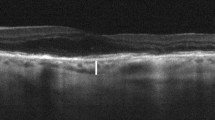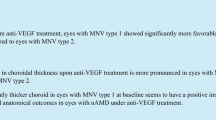Abstract
Purpose
To compare the subfoveal choroidal thickness (SFCT) between patients with neovascular age-related macular degeneration (nAMD) who had multiple intravitreal injections of anti-vascular endothelial growth factor (anti-VEGF) agents and those with treatment-naïve nAMD.
Methods
This retrospective case–control study included 15 patients in group 1 (nAMD in one eye which had received at least three anti-VEGF injections and early AMD in the fellow eye) and 15 patients in group 2 (newly diagnosed nAMD in one eye which had not received any treatment and early AMD in the fellow eye). They underwent enhanced depth imaging optical coherence tomography (OCT), and two OCT readers manually measured the SFCT. Inter-ocular difference in SFCT (nAMD eye minus fellow eye) was calculated for each patient.
Results
The nAMD eyes in group 1 had received a median (range) of four (3–8) intravitreal injections of anti-VEGF agents, and the OCT scans were performed at a median (range) of 9 (4–17) months after the first injection. The median inter-ocular difference in SFCT in groups 1 and 2 were not significantly different (13.5 and 3.0 μm in groups 1 and 2 respectively, p = 0.60). There was also no statistically significant difference in SFCT between nAMD and fellow eyes (p = 0.16), although there was a trend for greater median SFCT in the nAMD eyes.
Conclusion
The data from this small cohort suggests that no gross reduction in SFCT appears in nAMD patients after a time interval of at least 4 months between initiating repeated treatment with anti-VEGF therapy and OCT imaging. However, a study with a much larger sample size or longitudinal design is required to detect possible small fluctuations in SFCT in nAMD eyes receiving anti-VEGF therapy.


Similar content being viewed by others
References
Brown DM, Kaiser PK, Michels M, Soubrane G, Heier JS, Kim RY, Sy JP, Schneider S (2006) Ranibizumab versus verteporfin for neovascular age-related macular degeneration. N Engl J Med 355:1432–1444
Marneros AG, Fan J, Yokoyama Y, Gerber HP, Ferrara N, Crouch RK, Olsen BR (2005) Vascular endothelial growth factor expression in the retinal pigment epithelium is essential for choriocapillaris development and visual function. Am J Pathol 167:1451–1459
Nishijima K, Ng YS, Zhong L, Bradley J, Schubert W, Jo N, Akita J, Samuelsson SJ, Robinson GS, Adamis AP, Shima DT (2007) Vascular endothelial growth factor-A is a survival factor for retinal neurons and a critical neuroprotectant during the adaptive response to ischemic injury. Am J Pathol 171:53–67
Gaudreault J, Fei D, Beyer JC, Ryan A, Rangell L, Shiu V, Damico LA (2007) Pharmacokinetics and retinal distribution of ranibizumab, a humanized antibody fragment directed against VEGF-A, following intravitreal administration in rabbits. Retina 27:1260–1266
Heiduschka P, Fietz H, Hofmeister S, Schultheiss S, Mack AF, Peters S, Ziemssen F, Niggemann B, Julien S, Bartz-Schmidt KU, Schraermeyer U (2007) Penetration of bevacizumab through the retina after intravitreal injection in the monkey. Invest Ophthalmol Vis Sci 48:2814–2823
Schraermeyer U, Heiduschka P, Bartz-Schmidt KU (2009) Localisation of bevacizumab in the monkey retina after an intravitreal injection of Avastin. Ophthalmologe 106:619–624
Peters S, Heiduschka P, Julien S, Ziemssen F, Fietz H, Bartz-Schmidt KU, Schraermeyer U (2007) Ultrastructural findings in the primate eye after intravitreal injection of bevacizumab. Am J Ophthalmol 143:995–1002
Shimomura Y, Hirata A, Ishikawa S, Okinami S (2009) Changes in choriocapillaris fenestration of rat eyes after intravitreal bevacizumab injection. Graefes Arch Clin Exp Ophthalmol 247:1089–1094
Brown DM, Michels M, Kaiser PK, Heier JS, Sy JP, Ianchulev T (2009) Ranibizumab versus verteporfin photodynamic therapy for neovascular age-related macular degeneration: Two-year results of the ANCHOR study. Ophthalmology 116(1):57–65
McBain VA, Kumari R, Townend J, Lois N (2011) Geographic atrophy in retinal angiomatous proliferation. Retina 31:1043–1052
Spaide RF, Koizumi H, Pozzoni MC (2008) Enhanced depth imaging spectral-domain optical coherence tomography. Am J Ophthalmol 146:496–500
Bland JM, Altman DG (1986) Statistical methods for assessing agreement between two methods of clinical measurement. Lancet 1:307–310
Sakurai K, Akiyama H, Shimoda Y, Yoshida I, Kurabayashi M, Kishi S (2009) Effect of intravitreal injection of high-dose bevacizumab in monkey eyes. Invest Ophthalmol Vis Sci 50:4905–4916
Schraermeyer U, Julien S (2012) Formation of immune complexes and thrombotic microangiopathy after intravitreal injection of bevacizumab in the primate eye. Graefes Arch Clin Exp Ophthalmol 250(9):1303–1313, PMID:22614910
Yamazaki T, Koizumi H, Yamagishi T, Kinoshita S (2012) Subfoveal choroidal thickness after ranibizumab therapy for neovascular age-related macular degeneration: 12-month results. Ophthalmology 119(8):1621–1627
Spraul CW, Lang GE, Grossniklaus HE, Lang GK (1999) Histologic and morphometric analysis of the choroid, Bruch’s membrane, and retinal pigment epithelium in postmortem eyes with age-related macular degeneration and histologic examination of surgically excised choroidal neovascular membranes. Surv Ophthalmol 44(Suppl 1):S10–S32
Ramrattan RS, van der Schaft TL, Mooy CM, de Bruijn WC, Mulder PG, de Jong PT (1994) Morphometric analysis of Bruch’s membrane, the choriocapillaris, and the choroid in aging. Invest Ophthalmol Vis Sci 35:2857–2864
Sarks SH (1976) Ageing and degeneration in the macular region: a clinico-pathological study. Br J Ophthalmol 60:324–341
Rahman W, Chen FK, Yeoh J, Patel P, Tufail A, Da Cruz L (2011) Repeatability of manual subfoveal choroidal thickness measurements in healthy subjects using the technique of enhanced depth imaging optical coherence tomography. Invest Ophthalmol Vis Sci 52:2267–2271
Margolis R, Spaide RF (2009) A pilot study of enhanced depth imaging optical coherence tomography of the choroid in normal eyes. Am J Ophthalmol 147:811–815
Chen FK, Yeoh J, Rahman W, Patel PJ, Tufail A, Da Cruz L (2012) Topographic variation and interocular symmetry of macular choroidal thickness using enhanced depth imaging optical coherence tomography. Invest Ophthalmol Vis Sci 53(2):975–985
Ikuno Y, Kawaguchi K, Nouchi T, Yasuno Y (2010) Choroidal thickness in healthy Japanese subjects. Invest Ophthalmol Vis Sci 51(4):2173–2176
Chakraborty R, Read SA, Collins MJ (2011) Diurnal variations in axial length, choroidal thickness, intraocular pressure, and ocular biometrics. Invest Ophthalmol Vis Sci 52(8):5121–5129
Esmaeelpour M, Povazay B, Hermann B, Hofer B, Kajic V, Kapoor K, Sheen NJ, North RV, Drexler W (2010) Three-dimensional 1060-nm OCT: choroidal thickness maps in normal subjects and improved posterior segment visualization in cataract patients. Invest Ophthalmol Vis Sci 51(10):5260–5266
Ikuno Y, Tano Y (2009) Retinal and choroidal biometry in highly myopic eyes with spectral-domain optical coherence tomography. Invest Ophthalmol Vis Sci 50(8):3876–3880
Conflict of interest
The authors declare no conflict of interest.
Proprietary interests/funding
None
Author information
Authors and Affiliations
Corresponding author
Rights and permissions
About this article
Cite this article
Rahman, W., Chen, F.K., Yeoh, J. et al. Enhanced depth imaging of the choroid in patients with neovascular age-related macular degeneration treated with anti-VEGF therapy versus untreated patients. Graefes Arch Clin Exp Ophthalmol 251, 1483–1488 (2013). https://doi.org/10.1007/s00417-012-2199-x
Received:
Revised:
Accepted:
Published:
Issue Date:
DOI: https://doi.org/10.1007/s00417-012-2199-x




